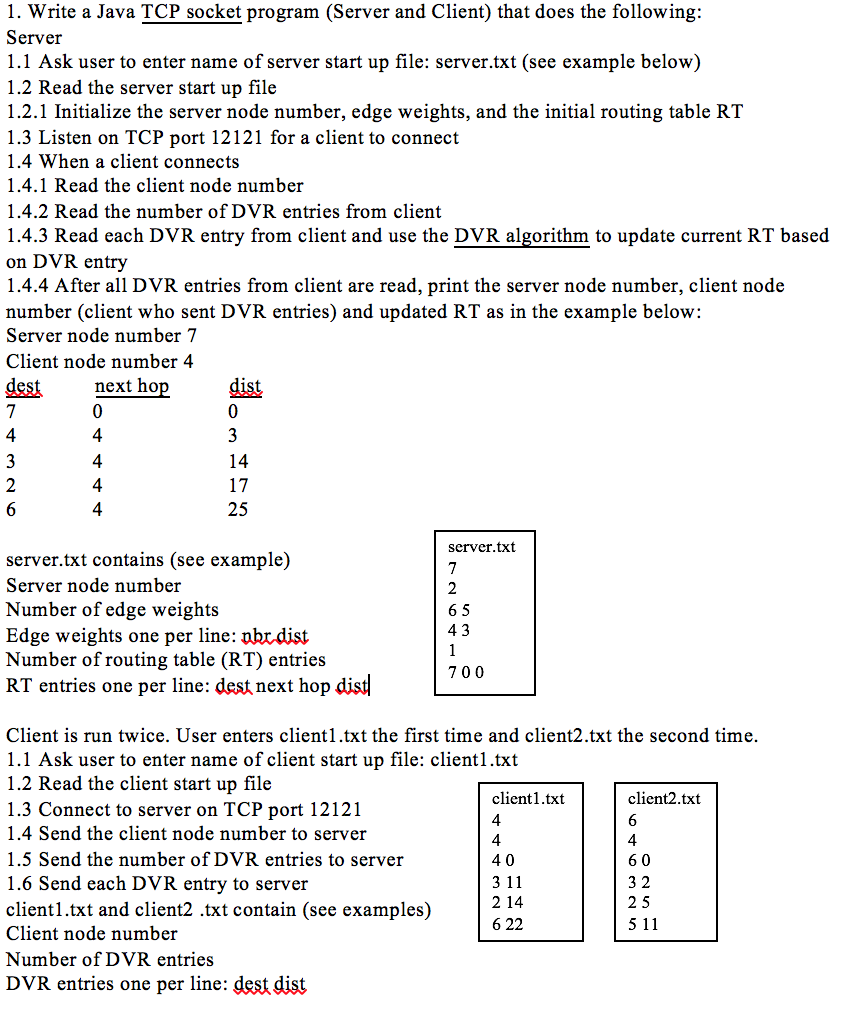Answered step by step
Verified Expert Solution
Question
1 Approved Answer
Network 1. Write a Java TCP socket program (Server and Client) that does the following: Server 1.1 Ask user to enter name of server start

Network
1. Write a Java TCP socket program (Server and Client) that does the following: Server 1.1 Ask user to enter name of server start up file: server.txt (see example below) 1.2 Read the server start up file 1.2.1 Initialize the server node number, edge weights, and the initial routing table RT 1.3 Listen on TCP port 12121 for a client to connect 1.4 When a client connects 1.4.1 Read the client node number 1.4.2 Read the number of DVR entries from client 1.4.3 Read each DVR entry from client and use the DVR algorithm to update current RT based on DVR entry 1.4.4 After all DVR entries from client are read, print the server node number, client node number (client who sent DVR entries) and updated RT as in the example below: Server node number 7 Client node number 4 next ho 0 4 17 25 server.txt server.txt contains (see example) Server node number Number of edge weights Edge weights one per line: nbrdist Number of routing table (RT) entries RT entries one per line: dest next hop dist 6 5 700 Client is run twice. User enters client1.txt the first time and client2.txt the second time. 1.1 Ask user to enter name of client start up file: clientl.txt 1.2 Read the client start up file 1.3 Connect to server on TCP port 12121 1.4 Send the client node number to server 1.5 Send the number of DVR entries to server 1.6 Send each DVR entry to server clientl.txt and client2 .txt contain (see examples) Client node number Number of DVR entries DVR entries one per line: dest dist client1.txt 4 4 40 3 11 2 14 6 22 client2.txt 6 4 6 0 3 2 2 5 5 11 1. Write a Java TCP socket program (Server and Client) that does the following: Server 1.1 Ask user to enter name of server start up file: server.txt (see example below) 1.2 Read the server start up file 1.2.1 Initialize the server node number, edge weights, and the initial routing table RT 1.3 Listen on TCP port 12121 for a client to connect 1.4 When a client connects 1.4.1 Read the client node number 1.4.2 Read the number of DVR entries from client 1.4.3 Read each DVR entry from client and use the DVR algorithm to update current RT based on DVR entry 1.4.4 After all DVR entries from client are read, print the server node number, client node number (client who sent DVR entries) and updated RT as in the example below: Server node number 7 Client node number 4 next ho 0 4 17 25 server.txt server.txt contains (see example) Server node number Number of edge weights Edge weights one per line: nbrdist Number of routing table (RT) entries RT entries one per line: dest next hop dist 6 5 700 Client is run twice. User enters client1.txt the first time and client2.txt the second time. 1.1 Ask user to enter name of client start up file: clientl.txt 1.2 Read the client start up file 1.3 Connect to server on TCP port 12121 1.4 Send the client node number to server 1.5 Send the number of DVR entries to server 1.6 Send each DVR entry to server clientl.txt and client2 .txt contain (see examples) Client node number Number of DVR entries DVR entries one per line: dest dist client1.txt 4 4 40 3 11 2 14 6 22 client2.txt 6 4 6 0 3 2 2 5 5 11Step by Step Solution
There are 3 Steps involved in it
Step: 1

Get Instant Access to Expert-Tailored Solutions
See step-by-step solutions with expert insights and AI powered tools for academic success
Step: 2

Step: 3

Ace Your Homework with AI
Get the answers you need in no time with our AI-driven, step-by-step assistance
Get Started


